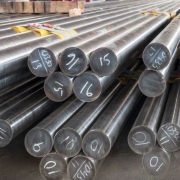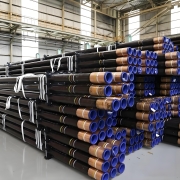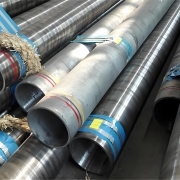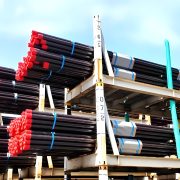สิ่งที่คุณต้องรู้: Super 13Cr
1. บทนำและภาพรวม
ซุปเปอร์ 13Cr เป็นโลหะผสมสเตนเลสมาร์เทนซิติกที่ขึ้นชื่อในเรื่องความแข็งแรงเชิงกลที่ยอดเยี่ยมและทนต่อการกัดกร่อนในระดับปานกลาง จึงเหมาะอย่างยิ่งสำหรับสภาพแวดล้อมที่ท้าทาย Super 13Cr ซึ่งพัฒนาขึ้นในตอนแรกสำหรับการใช้งานน้ำมันและก๊าซ ถือเป็นทางเลือกที่คุ้มต้นทุนสำหรับวัสดุที่มีโลหะผสมสูง โดยเฉพาะในสภาพแวดล้อมที่มีการกัดกร่อนในระดับปานกลาง ซึ่งการแตกร้าวจากการกัดกร่อนที่เกิดจากความเค้น (SCC) จากคลอไรด์เป็นปัญหา
เนื่องจากมีคุณสมบัติเชิงกลที่ดีขึ้นและมีความทนทานต่อการกัดกร่อนที่ดีขึ้นเมื่อเปรียบเทียบกับเหล็กกล้าไร้สนิม 13Cr ทั่วไป Super 13Cr จึงถูกนำมาใช้กันอย่างแพร่หลายในอุตสาหกรรมต่างๆ เช่น อุตสาหกรรมน้ำมันและก๊าซ การแปรรูปทางเคมี อุตสาหกรรมเยื่อและกระดาษ การเดินเรือและนอกชายฝั่ง การควบคุมมลพิษทางอากาศ และการผลิตไฟฟ้า
2. ผลิตภัณฑ์และข้อมูลจำเพาะ Super 13Cr ที่มีจำหน่าย
Super 13Cr มีให้เลือกหลายรูปแบบเพื่อตอบสนองความต้องการการใช้งานที่หลากหลาย:
- หมายเลข UNS: S41426
- ชื่อสามัญ:ซุปเปอร์ 13Cr
- น.ส.ว.: 1.4009
- มาตรฐาน ASTM/ASME:ASTM A276, A479, A182
- แบบฟอร์มผลิตภัณฑ์: ท่อ, หลอด, บาร์, ร็อด, สินค้าเหล็กดัด
3. การประยุกต์ใช้ Super 13Cr
การผสมผสานระหว่างความแข็งแกร่ง ความแข็ง และความทนทานต่อการกัดกร่อนของ Super 13Cr ทำให้เหมาะกับการใช้งานต่างๆ:
- น้ำมันและก๊าซ:ท่อ ปลอก และท่อส่งในสภาพแวดล้อมที่มีฤทธิ์กัดกร่อนเล็กน้อยโดยมี CO₂ และการสัมผัส H₂S ในปริมาณจำกัด
- การแปรรูปทางเคมี:อุปกรณ์และระบบท่อที่จัดการสารเคมีที่มีฤทธิ์รุนแรงปานกลาง
- เยื่อกระดาษและกระดาษ:ส่วนประกอบที่สัมผัสกับสภาพแวดล้อมการประมวลผลทางเคมีที่รุนแรง
- การเดินเรือและนอกชายฝั่ง:ส่วนประกอบในการจัดการน้ำทะเล รวมทั้งปั๊ม วาล์ว และโครงสร้างทางทะเลอื่นๆ
- การผลิตไฟฟ้า:ใบพัดและส่วนประกอบของกังหันไอน้ำถูกสัมผัสกับความร้อนและการกัดกร่อนที่สูง
- การควบคุมมลพิษทางอากาศ:ส่วนประกอบที่สัมผัสกับก๊าซไอเสียที่กัดกร่อนและสภาพแวดล้อมที่มีกรด
- การแปรรูปอาหาร:อุปกรณ์ที่ใช้ในสภาพแวดล้อมที่สุขอนามัยและความต้านทานการกัดกร่อนเป็นสิ่งสำคัญ
- เตาเผาที่พักอาศัยประสิทธิภาพสูง:เครื่องแลกเปลี่ยนความร้อนเนื่องจากวัสดุมีความทนทานต่ออุณหภูมิสูง
4. คุณสมบัติต้านทานการกัดกร่อน
เหล็กกล้าไร้สนิม Super 13Cr มีความทนทานต่อการกัดกร่อนได้ดีกว่าเหล็กกล้าไร้สนิม 13Cr ทั่วไป โดยเฉพาะในสภาพแวดล้อมที่มี CO₂ อย่างไรก็ตาม เหล็กกล้าไร้สนิมชนิดนี้ไม่เหมาะสำหรับสภาพแวดล้อมที่มีปริมาณ H₂S สูง เนื่องจากมีความเสี่ยงที่จะเกิดการแตกร้าวจากความเค้นของซัลไฟด์ โลหะผสมชนิดนี้มีความทนทานต่อการกัดกร่อนแบบหลุมและรอยแยกได้ดีในสภาพแวดล้อมที่มีคลอไรด์เป็นองค์ประกอบ และทนต่อการแตกร้าวจากการกัดกร่อนแบบเค้นภายใต้ความเข้มข้นของคลอไรด์ในระดับปานกลาง
5. สมบัติทางกายภาพและความร้อน
- ความหนาแน่น: 7.7 ก./ซม.³
- ช่วงการหลอมละลาย: 1,400–1,450 องศาเซลเซียส
- การนำความร้อน: 25 W/mK ที่ 20°C
- ความร้อนจำเพาะ: 460 จ/กก.·เคลวิน
- ค่าสัมประสิทธิ์การขยายตัวเนื่องจากความร้อน: 10.3 x 10⁻⁶/°C (20–100°C)
6.องค์ประกอบทางเคมี
องค์ประกอบทางเคมีทั่วไปของ Super 13Cr ประกอบด้วย:
- โครเมียม (Cr): 12.0–14.0%
- นิกเกิล (พรรณี): 3.5–5.5%
- โมลิบดีนัม (Mo): 1.5–2.5%
- คาร์บอน (ซี): ≤0.03%
- แมงกานีส (Mn): ≤1.0%
- ซิลิคอน (ศรี): ≤1.0%
- ฟอสฟอรัส (P): ≤0.04%
- ซัลเฟอร์ (S): ≤0.03%
- เหล็ก (Fe): สมดุล
7. คุณสมบัติทางกล
- ความต้านแรงดึง: 690–930 เมกะปาสคาล
- ความแข็งแรงของผลผลิต: 550–650 เมกะปาสคาล
- การยืดตัว: ≥20%
- ความแข็ง: 250–320 เอชบี
- แรงกระแทก:ดีเยี่ยม โดยเฉพาะหลังการอบด้วยความร้อน
8. การอบด้วยความร้อน
โดยทั่วไป Super 13Cr จะได้รับการชุบแข็งโดยการอบชุบด้วยความร้อนเพื่อปรับปรุงคุณสมบัติเชิงกล กระบวนการอบชุบด้วยความร้อนเกี่ยวข้องกับการดับและการอบชุบเพื่อให้ได้ความแข็งแรงและความเหนียวตามที่ต้องการ วงจรการอบชุบด้วยความร้อนทั่วไปประกอบด้วย:
- การอบสารละลาย:ให้ความร้อนถึง 950–1050°C แล้วจึงทำให้เย็นลงอย่างรวดเร็ว
- การแบ่งเบาบรรเทา:การอุ่นซ้ำที่อุณหภูมิ 600–700°C เพื่อปรับความแข็งและความเหนียว
9. การก่อตัว
Super 13Cr สามารถขึ้นรูปด้วยความร้อนหรือเย็นได้ แม้ว่าจะขึ้นรูปได้ยากกว่าเกรดออสเทนนิติกเนื่องจากมีความแข็งแรงมากกว่าและมีความเหนียวน้อยกว่า การอุ่นล่วงหน้าก่อนการขึ้นรูปและการให้ความร้อนหลังการขึ้นรูปมักจำเป็นเพื่อหลีกเลี่ยงการแตกร้าว
10. การเชื่อม
การเชื่อม Super 13Cr ต้องมีการควบคุมอย่างระมัดระวังเพื่อหลีกเลี่ยงการแตกร้าวและรักษาความต้านทานการกัดกร่อน โดยทั่วไปแล้วจะต้องให้ความร้อนล่วงหน้าและอบชุบด้วยความร้อนหลังการเชื่อม (PWHT) วัสดุอุดควรเข้ากันได้กับ Super 13Cr เพื่อให้แน่ใจว่าเชื่อมได้คุณภาพ ต้องดูแลเป็นพิเศษเพื่อหลีกเลี่ยงการเปราะเนื่องจากไฮโดรเจน
11. การกัดกร่อนของรอยเชื่อม
รอยเชื่อมใน Super 13Cr อาจเกิดการกัดกร่อนเฉพาะจุดได้ โดยเฉพาะในบริเวณที่ได้รับผลกระทบจากความร้อน (HAZ) การอบชุบด้วยความร้อนหลังการเชื่อมถือเป็นสิ่งสำคัญในการฟื้นคืนความต้านทานการกัดกร่อน ลดความเค้นตกค้าง และปรับปรุงความเหนียวในพื้นที่เชื่อม
12. การขจัดตะกรัน การดอง และการทำความสะอาด
การขจัดตะกรันของ Super 13Cr อาจเป็นเรื่องท้าทายเนื่องจากจะเกิดตะกรันออกไซด์ที่แข็งในระหว่างการอบชุบด้วยความร้อน วิธีการทางกล เช่น การพ่นทรายหรือการบำบัดด้วยสารเคมีโดยใช้สารละลายดองสามารถนำมาใช้ขจัดตะกรันได้ โลหะผสมต้องได้รับการทำความสะอาดอย่างทั่วถึงหลังการดองเพื่อหลีกเลี่ยงการปนเปื้อนและเพื่อให้แน่ใจว่ามีความต้านทานการกัดกร่อนที่เหมาะสมที่สุด
13. การชุบแข็งพื้นผิว
Super 13Cr สามารถผ่านการชุบแข็งพื้นผิว เช่น การไนไตรดิ้ง เพื่อเพิ่มความทนทานต่อการสึกหรอโดยไม่กระทบต่อความทนทานต่อการกัดกร่อน การไนไตรดิ้งช่วยเพิ่มความทนทานของโลหะผสมในสภาพแวดล้อมที่มีการเสียดสีและแรงเสียดทานสูง
บทสรุป
Super 13Cr นำเสนอโซลูชันอเนกประสงค์สำหรับอุตสาหกรรมที่ต้องมีความทนทานต่อการกัดกร่อนปานกลางและมีความแข็งแรงเชิงกลสูง คุณสมบัติที่สมดุลทำให้เป็นตัวเลือกที่นิยมในอุตสาหกรรมน้ำมันและก๊าซ การแปรรูปทางเคมี และการใช้งานทางทะเล เป็นต้น ด้วยการทำความเข้าใจลักษณะเฉพาะของ Super 13Cr ตั้งแต่ความทนทานต่อการกัดกร่อนไปจนถึงความสามารถในการเชื่อม วิศวกรและผู้เชี่ยวชาญด้านวัสดุจึงสามารถตัดสินใจอย่างรอบรู้เพื่อเพิ่มประสิทธิภาพและอายุการใช้งานในสภาพแวดล้อมเฉพาะของตนได้
โพสต์บล็อกนี้ให้ภาพรวมที่ครอบคลุมเกี่ยวกับคุณลักษณะและคุณสมบัติของ Super 13Cr ช่วยให้ภาคอุตสาหกรรมมีความรู้ในการใช้สารขั้นสูงนี้ให้เกิดประโยชน์สูงสุด





